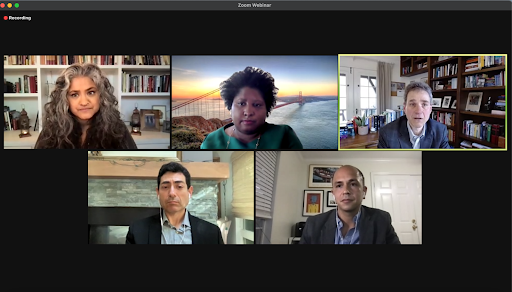Stanford Law School professor and former federal prosecutor David Sklansky said that the legal system and racism are inextricably linked during an interactive panel discussion about his latest book, “A Pattern of Violence: How the Law Classifies Crime and What It Means for Justice.”
“The story of the legal system’s response to violence cannot be disentangled from racism and America’s long history of dealing with racial subordination,” Sklansky said at Monday’s event hosted by the Stanford Criminal Justice Center, the Center for Comparative Studies on Race and Ethnicity and Stanford Law School.
The distinction between violent and non-violent crime has become normalized within the United States criminal legal system, according to Sklanksy. His book challenges the use of these categories and examines their contributions to issues such as mass incarceration and police brutality.
According to California Supreme Court Justice Mariano-Florentino Cuéllar M.A. ’96, this book “takes apart a category that we so often take for granted in law.”
While the categorization of some crimes as “violent” may sound descriptive, “what we call violent is really an evaluative decision,” according to Sklansky. For example, he pointed to how definitions of serious bodily injury vary by state and by individual judge. Ultimately, “it turns out to be a highly subjective decision, that can be, and often does, reflect racial bias,” he said.
The decision to label a crime as violent can often lead to instances of police violence because “anybody who is perceived as a violent criminal is almost pushed to the boundary of humanity, and can be treated differently,” said Adam Serwer, a staff writer at The Atlantic.
While cell phones have made it much easier to capture these moments, Sklansky said the focus on only the “spectacular” forms of violence captured on video, such as police shootings, obscures the violence of “ordinary, day to day, stop and frisk policing.”
Though much of Sklansky’s book was written during the Trump administration, he said that the problems he highlights did not go away when a new president was elected. Under President Biden’s administration, “we face a different set of challenges,” Sklansky said.
According to Sklansky, the demonizing of ‘violent’ offenders transcends political lines. For example, Governor Gavin Newsom, a Democrat representing the state of California, declared that he has no interest in releasing violent criminals from jail, despite the high infection rates of COVID-19 in California prisons. Mayor Bill de Blasio, a Democrat from New York, also criticized Brooklyn District Attorney Eric Gonzales’ diversion program aimed at keeping first-time offenders out of jail, claiming that they should not be used for violent offenses.
Across the political spectrum, politicians and citizens alike can and should begin to “imagine non-carceral, non-punitive ways to address harm,” said Sujatha Baliga, an attorney and restorative justice practitioner.
In order to accomplish this, Sklansky said that the categorization of violence should be eliminated, mandatory sentences should be reduced and opportunities for parole and clemency should be greatly expanded. He added that violence inside prisons should be more frequently addressed and not ignored simply because the victims of it are convicts.
When dealing with violence, Sklansky said that it is imperative that lawmakers, attorneys and politicians recognize that they are not just dealing with a trait that is a part of someone’s fundamental and inherent disposition — “We are dealing with a human being,” he said.
